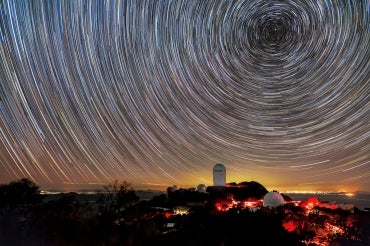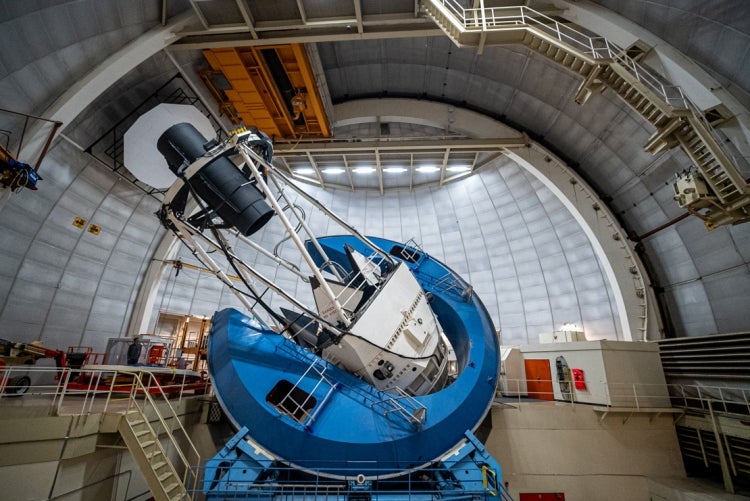Researchers say 3D map project is changing our understanding of the universe

The Kitt Peak National Observatory in Arizona, home to the Dark Energy Spectroscopic Instrument (photo by KPNO/NOIRLab/NSF/AURA/B. Tafreshi)
Published: April 8, 2025
A team of astronomers has created the largest 3D map of our universe to date and tracked dark energy’s influence on the evolution of the cosmos over the past 11 billion years.
Using the Dark Energy Spectroscopic Instrument (DESI) at the Kitt Peak National Observatory in Arizona, the researchers combined data from observing 15 million galaxies and quasars with other experiments to uncover signs that dark energy – the “force” powering the universe’s accelerating expansion – may be weakening over time instead of remaining constant.
This suggests that our understanding of how the universe works may need an update, researchers say.
“While we first saw hints of this in our previous results, the additional data has now strengthened this indication significantly,” says Ting Li, an assistant professor in the David A. Dunlap department of astronomy and astrophysics in the University of Toronto’s Faculty of Arts & Science and Dunlap Institute for Astronomy & Astrophysics who is chair of the DESI Milky Way Survey Working Group. “This finding suggests we may be on the brink of discovering entirely new physics beyond our current understanding.”
While the standard model of cosmology struggles to explain all the observations when taken together, a model where dark energy’s influence changes over time would seem to fit the data well.
“We need more data to confirm this with certainty, but if this is true, it means we do not understand the stuff that makes up 67 per cent of our universe,” says Tanveer Karim, a postdoctoral researcher at the Dunlap Institute and member of the DESI collaboration.
“The 3D map that DESI has produced is the most detailed 3D image of the universe produced to-date,” he says. “Before DESI, the largest such sample was the BOSS/eBOSS survey which measured distances to galaxies up to redshift of 1.1 – that is when the universe was 5.5 billion years old. DESI has pushed this limit to redshift of 1.6, or when the universe was 4 billion years old.”
The fate of the universe hinges on the balance between matter and dark energy, the fundamental ingredient that drives its accelerating expansion.
“What we are seeing is deeply intriguing,” says Alexie Leauthaud-Harnett, co-spokesperson for DESI and a professor at UC Santa Cruz. “It is exciting to think that we may be on the cusp of a major discovery about dark energy and the fundamental nature of our universe.”

Taken alone, DESI’s data are consistent with our standard model of the universe, but when paired with other measurements there are mounting indications that the impact of dark energy may be weakening over time and other models may be a better fit. Those other measurements include the light leftover from the dawn of the universe, the cosmic microwave background (CMB); exploding stars (supernovae); and how light from distant galaxies is warped by gravity, which is also known as weak lensing.
“We’re guided by Occam’s razor and the simplest explanation for what we see is shifting,” says Will Percival, co-spokesperson for DESI and a professor at the University of Waterloo. “It’s looking more and more like we may need to modify our standard model of cosmology to make these different datasets make sense together – and evolving dark energy seems promising.”
So far, the preference for an evolving dark energy has not met the threshold for a discovery in physics, but nevertheless appears to be inching closer.
“We're in the business of letting the universe tell us how it works and maybe the universe is telling us it's more complicated than we thought it was,” says Andrei Cuceu, a postdoctoral researcher at Lawrence Berkeley National Laboratory and co-chair of DESI’s Lyman-alpha working group, which uses the distribution of intergalactic hydrogen gas to map the distant universe.
“It's interesting and gives us more confidence to see that many different lines of evidence are pointing in the same direction.”
DESI is one of the most extensive surveys of the cosmos ever conducted. The state-of-the-art instrument can capture light from 5,000 galaxies simultaneously and is operated with funding from the U.S. Department of Energy’s Office of Science. With more than 900 researchers from over 70 institutions around the world, the DESI project is managed by the Berkeley Lab and is now in its fourth of five years surveying the sky, with plans to measure roughly 50 million galaxies and quasars – extremely distant yet bright objects with black holes at their cores – by the time the project ends.
“The University of Toronto has played a very active and substantial role in the DESI collaboration,” says Li. “At U of T, our team comprises three faculty members: Professor Ray Carlberg, [Assistant] Professor Josh Speagle and myself, as well as four postdoctoral fellows – including three Arts & Science fellows and one AI Schmidt Fellow, three graduate students and numerous undergraduate students – all actively contributing to the DESI project.”
With files from the Lawrence Berkeley National Laboratory
Read more about the project at the Faculty of Arts & Science



